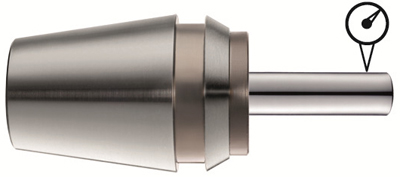TER Shrink Collet
TER Shrink Collet
Bilz Tool Inc. says its TER shrink collet from has proven to be a successful solution in the manufacturing of medical product technology. One specific application of the TER collet, is for machining vertebral supports from the titanium alloy Ti6AI4V.

Bilz Tool Inc. says its TER shrink collet from has proven to be a successful solution in the manufacturing of medical product technology. One specific application of the TER collet, is for machining vertebral supports from the titanium alloy Ti6AI4V.
Implants and supports in the vertebrae are helping more and more patients to overcome one of the most widespread disorders: back pain. The construction of the prostheses for this delicate part of the body is not easy. They must withstand very high stresses and must continue to function faultlessly for a long time. A large number of these high-tech implants are created at Ulrich Medical Ulm. The medical technology experts rely on TER collet chucks from BILZ for machining vertebral supports from the extremely strong titanium alloy Ti6AI4V. The TER collet and collet chuck system significantly lowers tool costs and productivity is increased.
Implants have been put into vertebrae since the middle of the 1980s. Medically speaking, this development has been a great step forward. In many cases, the prosthesis means that surgically induced stiffening of the vertebrae in the affected area becomes unnecessary and the body therefore retains flexibility. Titanium and titanium-based alloys are the materials most commonly chosen for constructing the prosthetic components for its resistance to corrosion. Titanium is also well-tolerated by the human body.
After the operation, an oxide layer develops on the surface of the implant and this becomes what is known medically as a "passivating" effect. None of the titanium passes into the body. This is true for the titanium alloy TiAI6V4. It has been clinically proven and is used by Ulrich Medical for a variety of vertebral support elements. Machining the surface in the shortest possible production time, while generating extremely precise results naturally presents a special challenge to the tool systems in use. Nevertheless, even in the highly demanding production environment of medical technology, considerable improvements in performance are possible. The use of two TER collet chucks from BILZ reportedly delivers this improvement.
Using the TER 1000/25 model, roughing an individual component on the drivel tool of a lathe requires a machining time of 30 seconds. The tool has a life of 1500 parts. The TER 0600/25 is used for finishing. The machining time for each component here is 17 seconds and the total tool life again is 1500 parts. A comparison shows how great the improvement behind these figures really is: the ER collet chuck, used in the past, led to much longer machining times (75 seconds for roughing, 20 seconds for finishing), and also yielded shorter tool life (500 parts for both roughing and finishing).
"The use of TER yields tool life about 300 percent longer. For any user, this brings a sharp drop in tool costs," explains Michael Schinke from BILZ.
The production planners at Ulrich Medical calculate that, with a batch size of 1500 components, tool costs are about 10 percent lower. In addition, the shorter machining time naturally means that significantly greater quantities can be manufactured.
It is the special design of the TER shrink-chuck from BILZ that delivers this success. With this chuck, Bilz is making the advantages of the shrink technique available to ER collet chucks designed for DIN6499 for the first time. The basic principle of the shrink technique is the same: the hole in the collet chuck is slightly smaller in diameter than the shaft of the tool. An alternating electromagnetic field generates inductive heating and the hole expands. The tool can now be inserted. In the subsequent cooling phase, the hole shrinks again and clamps the tool to create a solid, single piece that can withstand maximum torques.
Mira Babel, from Bilz marketing, states, "The TER shrink-chuck is providing a perfect example of the way the right clamping device can generate considerable price advantages in any production facility. Exact guidance of the tool minimizes both stress and wear. The example provided by Ulrich Medical also confirms the results of a large number of tests in which we have again measured increases in tool life of up to 300 percent."





